Origins
Following the Civil War, in 1866, leaders of the abolition and suffrage movements founded the American Equal Rights Association (AERA) to advocate for citizens' right to vote regardless of race or sex. Divisions among the group's members, which had existed from the outset, became apparent during the struggle over the ratification of two amendments to the United States Constitution. [4] [5] The proposed Fourteenth Amendment, which guaranteed equal protection of the laws to all citizens, regardless of race, color, creed, or previous condition of servitude, added the word "male" to the Constitution for the first time. The proposed Fifteenth Amendment extended franchise to African American men, but not to women. Following its contentious convention in May 1869, the AERA effectively dissolved. In its aftermath, two rival organizations were formed to campaign for women's suffrage. The National Woman Suffrage Association (NWSA) was formed at a hastily organized meeting two days after the last AERA convention. [6] Preparations for the formation of the rival American Woman Suffrage Association (AWSA) began soon afterward.
The AWSA was founded in November 1869 at a convention in Cleveland following the issuance of a call signed by more than 100 people from 25 states. [7] It was organized by leaders of the New England Woman Suffrage Association (NEWSA), which had been created in November 1868 as part of the developing split within the women's movement. The AWSA and the NEWSA operated separately with somewhat overlapping leadership. [8]
Wanting to differentiate themselves from NWSA leaders who had expressed hostility to male political influence, the AWSA founders made a point of inviting prominent male abolitionists and Republican politicians to sign the call to its founding convention. The first slate of officers consisted of equal numbers of men and women, and the convention agreed to alternate the presidency of the organization between a woman and a man. [9] Henry Ward Beecher was the first president of the AWSA, and Lucy Stone was chair of the executive committee. [10] Its headquarters were in Boston. [11]
African Americans attended the AWSA's founding convention and played important roles in the organization. Robert Purvis was elected vice president for Pennsylvania at that convention. [12] Frances Ellen Watkins Harper, also a founding member of the AWSA, [13] gave the closing address at the annual conventions in 1873 and 1875. [14]
Suffrage activists who hoped to prevent a split in the movement convinced Susan B. Anthony, one of the leaders of the NWSA, to attend the AWSA's founding convention. She was given a seat on the platform where she heard speeches voicing a determination to replace the NWSA. She rose to speak immediately after Lucy Stone's speech, offering to cooperate with the AWSA and saying the movement was more important than any one organization. [15] The split, however, continued for many years.
NWSA, led by Elizabeth Cady Stanton and Susan B. Anthony, condemned the Fifteenth Amendment as an injustice to women. In her The Revolution newsletter, Stanton periodically appealed to racism and ethnocentrism in order to distinguish female suffrage from black male suffrage: “ 'Patrick and Sambo and Hans and Yung Tung, who do not know the difference between a monarchy and a republic,' declared Stanton, had no right to be “making laws for [feminist leader] Lucretia Mott.” ' [16] The AWSA, which included Lucy Stone, Frances Ellen Watkins Harper, Henry Blackwell, Julia Ward Howe and Josephine Ruffin, strongly supported the Republican Party and the Fifteenth Amendment, which they felt would not win congressional approval if it included the vote for women. Another member was abolitionist and women's rights advocate Sojourner Truth. [17]
In 1870, Lucy Stone, the leader of the AWSA, began publishing an eight-page weekly newspaper called the Woman's Journal as the voice of the AWSA. Eventually it became a voice of the women's movement as a whole. [18]
The AWSA was initially larger than the NWSA, but it declined in strength during the 1880s. [19] Stanton and Anthony, the leading figures in the NWSA, were more widely known as leaders of the women's suffrage movement during this period and more influential in setting its direction. [20]
During the 1880s, it became increasingly clear that group rivalries were counterproductive to the goal of votes for women. [21] Conversations about a merger between the AWSA and NWSA began in 1886. [22] After several years of negotiations, the organizations officially joined in 1890 to form the National American Woman Suffrage Association (NAWSA). [23] The leaders of this new organization included Elizabeth Cady Stanton, Susan B. Anthony, Carrie Chapman Catt, Frances Willard, Mary Church Terrell, Matilda Joslyn Gage and Anna Howard Shaw. Stanton served in a largely ceremonial capacity as the NAWSA's first president while Anthony was its leading force in practice. The suffrage movement distanced itself from labor groups and kept its focus on the more affluent levels of society.
The first three volumes of the six-volume History of Woman Suffrage were written by the leaders of the NWSA prior to the merger. It included a 107-page chapter on the history of the AWSA, the NWSA's bitter rival, but provided much more information about the NWSA itself that was written from its own point of view. This unbalanced portrayal of the movement influenced scholarly research in this field for many years. Not until about the middle of the 20th century did the AWSA begin to receive adequate scholarly attention. [24]
Lucy Stone
Lucy Stone was born on August 13, 1818 in West Brookfield Massachusetts. [25] She began her career as a teacher in order to save enough money to pay for her college education, eventually at the age of 25 she had earned enough to begin school at Oberlin, which was the only college that would admit women during the early 1800s. [25]
Stone gave her first public speech at Oberlin, but received a great amount of backlash from the Ladies Board, calling her actions "unwomanly" and "unscriptural." [25] Stone graduated from Oberlin in 1847, and gave her first woman's right lecture the same year. [25] Stone's early work consisted of a mix between woman's rights and anti-slavery lectures, but eventually resigned from the Anti-Slavery Society in order to devote herself to the fight for woman's rights. [25]
Stone began her fight for suffrage alone, as no suffrage associations had been established at the time, she received a great deal of backlash from the public, still she continued to travel across the United States to give her lectures, and was greeted with a large audience at almost every lecture. [25] She managed to have control over her crowds and they began to respect her efforts even if they didn't necessarily agree with her. Stone married Henry Blackwell in 1855 who felt strongly about woman's rights and was an abolitionist. Stone never changed her name throughout the 40 years they were happily married. The two of them lectured together and took part in a multitude of campaigns where suffrage amendments had been submitted for the popular vote. [25]
In 1866 Stone helped organize The Equal Rights Association which advocated from equal rights among African Americans and women. She then went on to organize the American Woman's Suffrage Association, sitting as chairman for its executive branch for almost twenty years. [25] Then with the money she earned through her work she funded the Woman's Journal in 1870, working on it with her husband to give woman a space to advocate for themselves, the journal was passed down to her daughter and continued to thrive as a space of change for women across the United States of America. [25]
Woman's Journal
The Woman's Journal played a fundamental role in the AWSA's ability to get their message and wants out into the public sphere.
The Woman's Journal became the heart and soul of the AWSA's mission. Lucy Stone and Henry Blackwell founded the journal in 1870, their daughter Alice eventually joined the journal's staff by becoming the sole editor after her parents passing. [30] The journal never had any immense financial success attached to it, but it received widespread attention which heavily contributed to the Woman's Suffrage Movement. The journal covered a number of topics including the information regarding local conventions and events and it reported back on speeches including those at the New England Woman's Tea Party. The journal offered updates and tracked progress across the US on woman's suffrage victories. [31] It also offered insights from the readers including editorials, letters from supporters, debates on other woman's rights issues, short stories and poetry. [31]
The journal was eventually sold to the Leslie Woman Suffrage Commission who was headed by Carrie Chapman Catt, the journal was renamed to The Woman Citizen [30] , three years later the 19th amendment was passed, and their was a decline in activism regarding the general sphere of woman's rights. The journal continued to publish, but now only monthly compared to their weekly publications, this lasted for a little over a decade until the journal finally called an end to publication in 1931. [30]
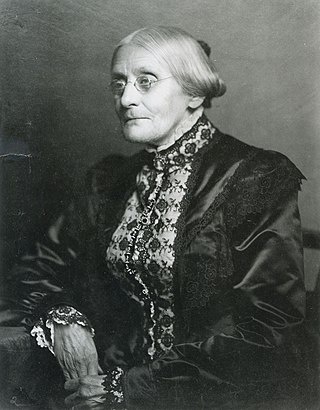
Susan B. Anthony was an American social reformer and women's rights activist who played a pivotal role in the women's suffrage movement. Born into a Quaker family committed to social equality, she collected anti-slavery petitions at the age of 17. In 1856, she became the New York state agent for the American Anti-Slavery Society.

The Nineteenth Amendment to the United States Constitution prohibits the United States and its states from denying the right to vote to citizens of the United States on the basis of sex, in effect recognizing the right of women to vote. The amendment was the culmination of a decades-long movement for women's suffrage in the United States, at both the state and national levels, and was part of the worldwide movement towards women's suffrage and part of the wider women's rights movement. The first women's suffrage amendment was introduced in Congress in 1878. However, a suffrage amendment did not pass the House of Representatives until May 21, 1919, which was quickly followed by the Senate, on June 4, 1919. It was then submitted to the states for ratification, achieving the requisite 36 ratifications to secure adoption, and thereby went into effect, on August 18, 1920. The Nineteenth Amendment's adoption was certified on August 26, 1920.
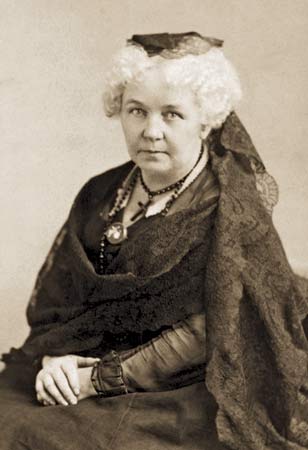
Elizabeth Cady Stanton was an American writer and activist who was a leader of the women's rights movement in the U.S. during the mid- to late-19th century. She was the main force behind the 1848 Seneca Falls Convention, the first convention to be called for the sole purpose of discussing women's rights, and was the primary author of its Declaration of Sentiments. Her demand for women's right to vote generated a controversy at the convention but quickly became a central tenet of the women's movement. She was also active in other social reform activities, especially abolitionism.

Lucy Stone was an American orator, abolitionist and suffragist who was a vocal advocate for and organizer of promoting rights for women. In 1847, Stone became the first woman from Massachusetts to earn a college degree. She spoke out for women's rights and against slavery. Stone was known for using her birth name, after marriage, contrary to the custom of women taking their husband's surname.

The National Woman Suffrage Association (NWSA) was formed on May 15, 1869, to work for women's suffrage in the United States. Its main leaders were Susan B. Anthony and Elizabeth Cady Stanton. It was created after the women's rights movement split over the proposed Fifteenth Amendment to the U. S. Constitution, which would in effect extend voting rights to black men. One wing of the movement supported the amendment while the other, the wing that formed the NWSA, opposed it, insisting that voting rights be extended to all women and all African Americans at the same time.
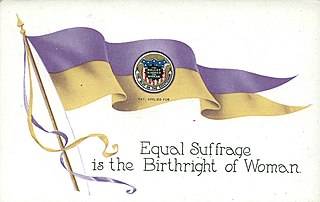
The National American Woman Suffrage Association (NAWSA) was an organization formed on February 18, 1890, to advocate in favor of women's suffrage in the United States. It was created by the merger of two existing organizations, the National Woman Suffrage Association (NWSA) and the American Woman Suffrage Association (AWSA). Its membership, which was about seven thousand at the time it was formed, eventually increased to two million, making it the largest voluntary organization in the nation. It played a pivotal role in the passing of the Nineteenth Amendment to the United States Constitution, which in 1920 guaranteed women's right to vote.
The Revolution was a newspaper established by women's rights activists Susan B. Anthony and Elizabeth Cady Stanton in New York City. It was published weekly between January 8, 1868, and February 17, 1872. With a combative style that matched its name, it primarily focused on women's rights, especially prohibiting discrimination against women's suffrage in the United States, and women's suffrage in general. It also covered other topics, such as politics, the labor movement, and finance. Anthony managed the business aspects of the paper, while Stanton was co-editor along with Parker Pillsbury, an abolitionist and a supporter of women's rights.

Alice Stone Blackwell was an American feminist, suffragist, journalist, radical socialist, and human rights advocate.

Women's suffrage, or the right of women to vote, was established in the United States over the course of the late 19th and early 20th centuries, first in various states and localities, then nationally in 1920 with the ratification of the 19th Amendment to the United States Constitution.

The Women's Loyal National League, also known as the Woman's National Loyal League and other variations of that name, was formed on May 14, 1863, to campaign for an amendment to the U.S. Constitution that would abolish slavery. It was organized by Elizabeth Cady Stanton, its president, and Susan B. Anthony, its secretary. In the largest petition drive in the nation's history up to that time, the League collected nearly 400,000 signatures on petitions to abolish slavery and presented them to Congress. Its petition drive significantly assisted the passage of the Thirteenth Amendment, which ended slavery in the U.S. The League disbanded in August 1864 after it became clear that the amendment would be approved.
Hannah Maria Conant Tracy Cutler was an American abolitionist as well as a leader of the temperance and women's suffrage movements in the United States. Cutler served as president of the Ohio Woman Suffrage Association and the American Woman Suffrage Association (AWSA). Cutler helped to shape the merger of two feminist factions into the combined National American Woman Suffrage Association (NAWSA).

The American Equal Rights Association (AERA) was formed in 1866 in the United States. According to its constitution, its purpose was "to secure Equal Rights to all American citizens, especially the right of suffrage, irrespective of race, color or sex." Some of the more prominent reform activists of that time were members, including women and men, blacks and whites.

The New England Woman Suffrage Association (NEWSA) was established in November 1868 to campaign for the right of women to vote in the U.S. Its principal leaders were Julia Ward Howe, its first president, and Lucy Stone, who later became president. It was active until 1920, when suffrage for women was secured by the Nineteenth Amendment to the U.S. Constitution.
This timeline highlights milestones in women's suffrage in the United States, particularly the right of women to vote in elections at federal and state levels.
History of Woman Suffrage is a book that was produced by Elizabeth Cady Stanton, Susan B. Anthony, Matilda Joslyn Gage and Ida Husted Harper. Published in six volumes from 1881 to 1922, it is a history of the women's suffrage movement, primarily in the United States. Its more than 5700 pages are the major source for primary documentation about the women's suffrage movement from its beginnings through the ratification of the Nineteenth Amendment to the U.S. Constitution, which enfranchised women in the U.S. in 1920. Written from the viewpoint of the wing of the movement led by Stanton and Anthony, its coverage of rival groups and individuals is limited.

Women's suffrage was established in the United States on a full or partial basis by various towns, counties, states, and territories during the latter decades of the 19th century and early part of the 20th century. As women received the right to vote in some places, they began running for public office and gaining positions as school board members, county clerks, state legislators, judges, and, in the case of Jeannette Rankin, as a member of Congress.

Sarah Burger Stearns was a social reformer and a leader in the woman's suffrage movement in the U.S. state of Minnesota. She co-founded the Minnesota Woman Suffrage Association and served as its first president.
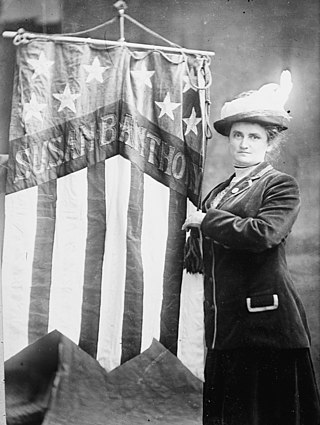
Lucy Elmina Anthony was an internationally known leader in the American woman's suffrage movement. She was the niece of American social reformer and women's rights activist, Susan B. Anthony, and longtime companion of women's suffrage leader, Anna Howard Shaw. She served as a secretary to both women, as well as on the committee on local arrangements for the National Woman Suffrage Association (NWSA)

United States v. Susan B. Anthony was the criminal trial of Susan B. Anthony in a U.S. federal court in 1873. The defendant was a leader of the women's suffrage movement who was arrested for voting in Rochester, New York in the 1872 elections in violation of state laws that allowed only men to vote. Anthony argued that she had the right to vote because of the recently adopted Fourteenth Amendment to the U.S. Constitution, part of which reads, "No State shall make or enforce any law which shall abridge the privileges or immunities of citizens of the United States."
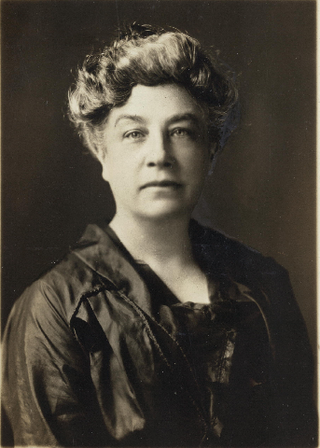
The Southern States Woman Suffrage Conference was a group dedicated to winning voting rights for white women. The group consisted mainly of highly educated, middle and upper class white women of prominent families. They were originally part of the larger National American Woman Suffrage Association (NAWSA), but broke off in 1906. Prominent leaders in the group included Laura Clay and Kate Gordon, who supported and focused on local and state reforms rather than a national amendment. The group applied tactics like the Lost Cause, the belief that the Confederate cause was moral and just, and the Southern strategy, which appealed to white voters by promoting racism.

















